Osten House
1770 establishments in DenmarkHouses completed in 1770Houses in Helsingør MunicipalityListed buildings and structures in Helsingør MunicipalityRococo architecture in Denmark

The Osten House (Danish Ostens Gård) is a Rococo-style townhouse located at Stengade 83 in Helsingør, Denmark. The building was listed on the Danish registry of protected buildings and places in 1918.
Excerpt from the Wikipedia article Osten House (License: CC BY-SA 3.0, Authors, Images).Osten House
Stengade, Helsingør Municipality
Geographical coordinates (GPS) Address Nearby Places Show on map
Geographical coordinates (GPS)
| Latitude | Longitude |
|---|---|
| N 56.035833333333 ° | E 12.615716666667 ° |
Address
Stengade 83A
3000 Helsingør Municipality
Capital Region of Denmark, Denmark
Open on Google Maps










